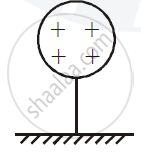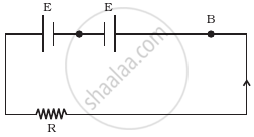Advertisements
Advertisements
प्रश्न
A metal sphere is kept on an insulting stands. A negatively charged rod is brought near it, then the sphere is earthed as shown. On removing the earthing, and taking the negatively charged rod away, what will be the nature of charge on the sphere? Give reason for your answer.

उत्तर १
There will be positive charge on the sphere.

Reason :
Negatively charged rod will induce positive charge on the sphere and negative charge well move in ground from other end.
उत्तर २
When we bring a negatively charged rod near the metal sphere, the free electrons in the sphere move away due to repulsion force and start piling up at the other end. The rear end becomes positively charged due to the deficit of electrons. After connecting the sphere to the ground, the electrons flow to the ground while the positive charges at the rear end remain as it is due to the attractive force of the negative charges on the rod. When the sphere is disconnected from the ground and the charged rod is removed, the positive charge spreads uniformly over the sphere as shown in the Figure below:

संबंधित प्रश्न
The relationship between the potential difference and the current in a conductor is stated in the form of a law.
1) Name the law.
2) What does the slope of V-I graph for a conductor represent?
3) Name the material used for making the connecting wire.
Four resistances of 16 ohms each are connected in parallel. Four such combinations are connected in series. What is the total resistance?
Calculate the electric field in a copper wire of cross-sectional area 2.0 mm2 carrying a current of 1 A.
The resistivity of copper = 1.7 × 10–8 Ω m
Define ampere and volt with respect to Ohm’s law.
The resistance of a nichrome wire at 0°C is 10Ω. If its temperature coefficient of resistivity of nichrome is 0.004/ °C, find its resistance of the wire at boiling point of water. Comment on the result.
Which of the following is correct for V-I graph of a good conductor?
State Ohm’s law? How can it be verified experimentally? Does it hold good under all conditions? Comment.
Ohm's law deals with the relationship between ______
Two cells of same emf E but internal resistance r1 and r2 are connected in series to an external resistor R (Figure). What should be the value of R so that the potential difference across the terminals of the first cell becomes zero.
